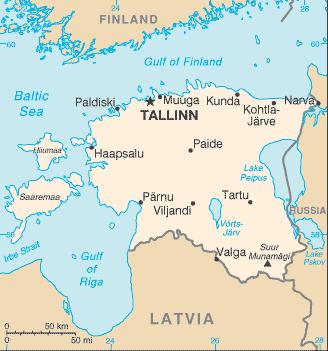

After centuries of Danish, Swedish, German, and Russian
rule, Estonia attained independence in 1918. Forcibly incorporated into the
USSR in 1940, it regained its freedom in 1991, with the collapse of the Soviet
Union. Since the last Russian troops left in 1994, Estonia has been free to
promote economic and political ties with Western Europe. It joined both NATO
and the EU in the spring of 2004.
Location: Eastern Europe, bordering the Baltic Sea and
Gulf of Finland, between Latvia and Russia
Geographic coordinates: 59 00 N, 26 00 E
Area: total: 45,226 sq km (land: 43,211 sq km, water: 2,015 sq km, note: includes
1,520 islands in the Baltic Sea)
Land boundaries: total: 633 km (Latvia 339 km, Russia
294 km)
Coastline: 3,794 km
Climate: maritime, wet, moderate winters, cool summers
Terrain: marshy, lowlands; flat in the north, hilly in the south
Elevation extremes: lowest point: Baltic Sea 0 m, highest point: Suur Munamagi
318 m
Population: 1,341,664 (July 2004 est.)
Median age: total: 38.8 years
Ethnic groups: Estonian 65.3%, Russian 28.1%, Ukrainian 2.5%, Belarusian 1.5%,
Finn 1%, other 1.6% (1998)
Religions: Evangelical Lutheran, Russian Orthodox, Estonian Orthodox, Baptist,
Methodist, Seventh-Day Adventist, Roman Catholic, Pentecostal, Word of Life,
Jewish
Languages: Estonian (official), Russian, Ukrainian, Finnish, other
Literacy: 99.8%
Country name: Republic of Estonia (conventional short form:
Estonia)
Government type: parliamentary republic
Capital: Tallinn
Administrative divisions: 15 counties (maakonnad, singular - maakond): Harjumaa
(Tallinn), Hiiumaa (Kardla), Ida-Virumaa (Johvi), Jarvamaa (Paide), Jogevamaa
(Jogeva), Laanemaa (Haapsalu), Laane-Virumaa (Rakvere), Parnumaa (Parnu), Polvamaa
(Polva), Raplamaa (Rapla), Saaremaa (Kuressaare), Tartumaa (Tartu), Valgamaa
(Valga), Viljandimaa (Viljandi), Vorumaa (Voru)
Independence: 20 August 1991 (from Soviet Union)
National holiday: Independence Day, 24 February (1918); note - 24 February 1918
is the date Estonia declared its independence from Soviet Russia; 20 August
1991 is the date it declared its independence from the Soviet Union
Suffrage: 18 years of age; universal for all Estonian citizens
Estonia, as a new member of the World Trade Organization,
is steadily moving toward a modern market economy with increasing ties to the
West, including the pegging of its currency to the euro. The economy benefits
from strong electronics and telecommunications sectors. Estonia has been invited
to join the European Union and will do so in May 2004. The economy is greatly
influenced by developments in Finland, Sweden, Russia, and Germany, four major
trading partners. The high current account deficit remains a concern. However,
the state budget enjoyed a surplus of $130 million in 2003.
GDP - per capita: $12,300 (2003 est.)
Unemployment rate: 10.1% (2003)
Exports - partners: Finland 21.9%, Sweden 12.5%, Russia 11.4%, Germany 8.4%,
Latvia 7.4%, Lithuania 4% (2003)
Imports - partners: Finland 15.9%, Germany 11.1%, Russia 10.2%, Sweden 7.7%,
Ukraine 4.3%, China 4.2%, Japan 4.1% (2003)
Currency: Estonian kroon (EEK)
Internet country code: .ee